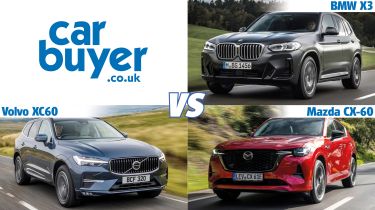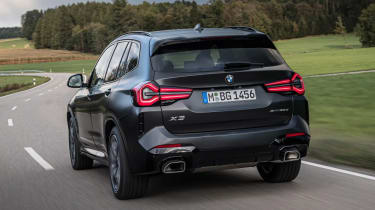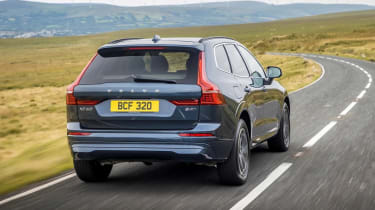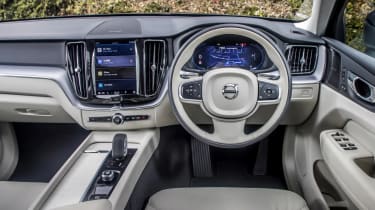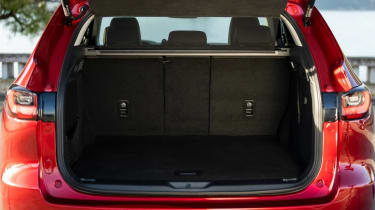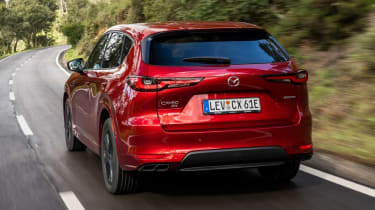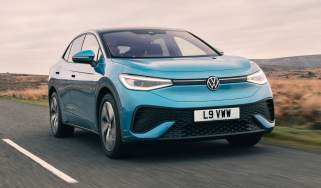BMW X3 vs Mazda CX-60 vs Volvo XC60 – which should you buy?
Looking for a fuel-sipping family SUV that oozes premium appeal? We compare three of the best options on sale
Family cars come in all shapes and sizes – from saloons and hatchbacks, to estates and MPVs. However, SUVs have quickly become the go-to option for many families as they provide a unique combination of everyday practicality and supermarket car park kudos.
 The best mid-size SUVs – our 2025 top picks
The best mid-size SUVs – our 2025 top picks
With family SUVs now so popular, there are plenty of options to choose from; ranging from mainstream models like the Skoda Karoq to desirable performance SUVs such as the Maserati Grecale. In the middle lies a collection of premium models that offer many of the luxury touches of higher-end SUVs, without the astronomical price tags.
We’ve picked three of the best premium family SUVs on the market right now – the BMW X3, the Mazda CX-60 and the Volvo XC60 – and compared them to see which one should make its way onto your driveway. While we have not yet driven them side-by-side, we have in-depth reviews that you can check out for a more detailed opinion on each model. For now at least, read on to see which one we think is best.
Which is the best to drive?
In a world full of comfortable crossovers, it's easy to forget that the ‘S’ in ‘SUV’ stands for ‘Sport’. The Volvo XC60 is a key example of why the ‘SUV’ title is often a bit of a misnomer as it has been designed first and foremost to provide the most relaxed driving experience possible. Of course, that’s not necessarily a bad thing as the Volvo is probably the best option of these three for busy city driving. However, when you encounter a twisty road you’ll find the XC60 leans a lot through the bends and that its steering is far from the sharpest.
You may be surprised to hear that the CX-60 is, in fact, Mazda’s most powerful production model to date. Yet, while it may not quite have the agility of the smaller Mazda MX-5 or the charisma of the wankel-engined RX-8, the CX-60 can still offer plenty of fun. The Mazda’s 335bhp plug-in hybrid powertrain has less power than either of those offered in the Volvo, but the Japanese SUV is still more fun to drive. With a steering setup that’s almost identical to the aforementioned MX-5, the CX-60 feels surprisingly sporty despite its two-tonne weight. A less-powerful but lighter diesel model is also on the way which should feel even more spry.
However, it’s the BMW that comes closest to being the ‘Ultimate Driving Machine’. All X3s get BMW’s slick xDrive all-wheel-drive system; this is able to redistribute power between the front and rear axles to maintain the maximum amount of grip. The plug-in hybrid X3 xDrive30e outputs a healthy 288bhp, however buyers will want to choose the 335bhp petrol-powered X3 M40i model if they wish to make the most of the BMW’s finely-tuned chassis.
Which is the cheapest to run?
Efficiency may not be the first thing that comes to mind when you think of two-tonne luxury 4x4s; however, all three of these cars are available with diesel and plug-in hybrid powertrains, making them more efficient than you might expect.
The BMW X3’s 2.0-litre diesel engine can return up to 47.8mpg and is a solid choice for private buyers. The more expensive plug-in hybrid is the best bet for company car drivers, however, with its low Benefit in-Kind tax rating and 30-mile electric range. Unlike the Mazda, the X3 is also available with a selection of punchy petrol engines, though these are best reserved for lower-mileage drivers.
Moving on, the Volvo XC60 can be configured with one of two petrol or plug-in hybrid powertrains, plus there’s also one diesel option on offer. This, dubbed the B4, can return up to 44.1mpg, while both petrols can still manage over 35mpg thanks to mild-hybrid assistance. It's Volvo's plug-in hybrid offerings that truly shine, however, as both the lower and higher-powered setups on the XC60 provide almost 60 miles of pure-electric range. This means that some drivers may end up driving the Volvo on electric power alone, drastically cutting running costs.
Expected to join the range in 2023, the Mazda CX-60’s diesel engine should return up to 57.6 mpg. In the meantime, the only model available is the plug-in hybrid with its 39-mile electric range; this places the Mazda squarely between the BMW and the Volvo. That said, the CX-60 PHEV starts from just over £43,000 – £13,000 less than the equivalent XC60. While this may not be so much of an issue for company car drivers, private buyers could save a substantial amount of cash opting for the Mazda, despite its shorter range.
Which has the best interior?
One of the defining features of a premium SUV is its plush interior. Here, buyers should expect plenty of sumptuous materials such as leather and Alcantara suede, as well as the latest technology to keep you and your family safe and connected.
Step inside the CX-60 and it’d be easy to think you’re sitting in a much more expensive luxury car – ignoring the plethora of ‘Mazda’ badges, of course. The overall design is minimalist and classy and Mazda has incorporated several nods to its Japanese heritage in the form of traditional stitching patterns and lighting techniques. Although the Japanese are certainly famous for their technology, the Mazda can’t quite match its rivals in this respect. The CX-60 utilises a rotary dial controller for its infotainment system instead of a touchscreen; this makes it safer to use when on the move, but the system itself just isn’t quite as intuitive nor as feature-packed as those found elsewhere.
In contrast, the BMW X3’s interior can only be described as a tech-fest. The brand’s iDrive system is among the best on the market and can be controlled either via a rotary dial in the centre console or by the 12.3-inch touchscreen on the dashboard. This is supplemented by a set of 12.3-inch digital dials; drivers can configure this to display several of the car’s functions such as the sat-nav map or whatever music you currently have playing. Looking elsewhere, the layout of the X3’s interior is somewhat conservative, but build and material quality is perhaps the strongest here.
If it's wow-factor you’re after, however, neither of the two other cars’ cabins come close to that of the Volvo XC60. The overall design of the XC60’s cabin is typically Scandinavian, with plenty of natural materials and very little clutter. The centre of the dashboard is dominated by a nine-inch portrait-style touchscreen; this may not quite be as slick as the one in the BMW, but it is still straightforward to operate. Another highlight are Volvo’s orthopaedic seats which look as good as they are comfortable to sit in.
Which is the most practical?
Other than their undeniable kerb appeal, perhaps the most popular reason for choosing an SUV over the equivalent saloon or hatchback is the added practicality. Volvo has long been renowned for its practical estate cars and while the XC60 should offer ample space for most families, the SUV falls short of its rivals. Open up the standard electric tailgate and you’re greeted by 505 litres of space – 14 litres less than the equivalent Volvo V60 estate. On the bright side, this figure doesn’t change for the hybrid model, plus the Volvo’s boxy shape means rear passengers have plenty of headroom.
Next up is the BMW, which boasts 550 litres of space in the boot; unfortunately, plug-in hybrid models have to make do with just 450 litres due to components mounted underneath the boot floor. The X3’s cabin is incredibly spacious, though, allowing three people to sit abreast in the rear with relative comfort, despite the large hump in the middle of the floor.
The title of the most spacious car here goes to the Mazda CX-60, however. The CX-60’s boot measures a cavernous 570 litres – even with the plug-in hybrid powertrain fitted. As for passenger space, the extended wheelbase (the distance between the front and rear wheels) over the smaller Mazda CX-5 means there is plenty of legroom in the back seats.
Which should I buy?
No matter which one you choose, all three of these SUVs are a great choice for anyone looking to upgrade to something posh, with less-than-premium running costs. The BMW will mostly appeal to driving enthusiasts and tech geeks, with its engaging handling and gizmo-filled interior. The Volvo is an astute pick for those after comfort, while the plug-in hybrid’s near-60-mile range will vastly reduce running costs for company car drivers.
However, it’s the Mazda that, on paper, is the most complete package. The CX-60 is almost as sharp to drive as the BMW, while its powertrains closely match the Volvo in terms of efficiency. The 39-mile electric range of the plug-in hybrid model may not be class-leading, but it should provide a welcome introduction to zero-emissions motoring for those not quite ready to make the switch to a fully-electric car. In reality, the only thing the Mazda doesn’t offer in comparison to the other two cars is a premium image – so badge snobs beware!
Want to see what other options are out there? Check out our list of the top 10 best hybrid SUVs
Recommended

New Volvo XC60 gets a tech upgrade, yours from £48k
Most Popular

New Smart #5 Brabus is a 637bhp far cry from the brand’s city car past

Best car leasing deals 2025: this week’s top PCH offers
Tips & advice

Car dashboard warning lights: what does each symbol mean?

Electric car charging stations: public networks, charger types, apps and maps


